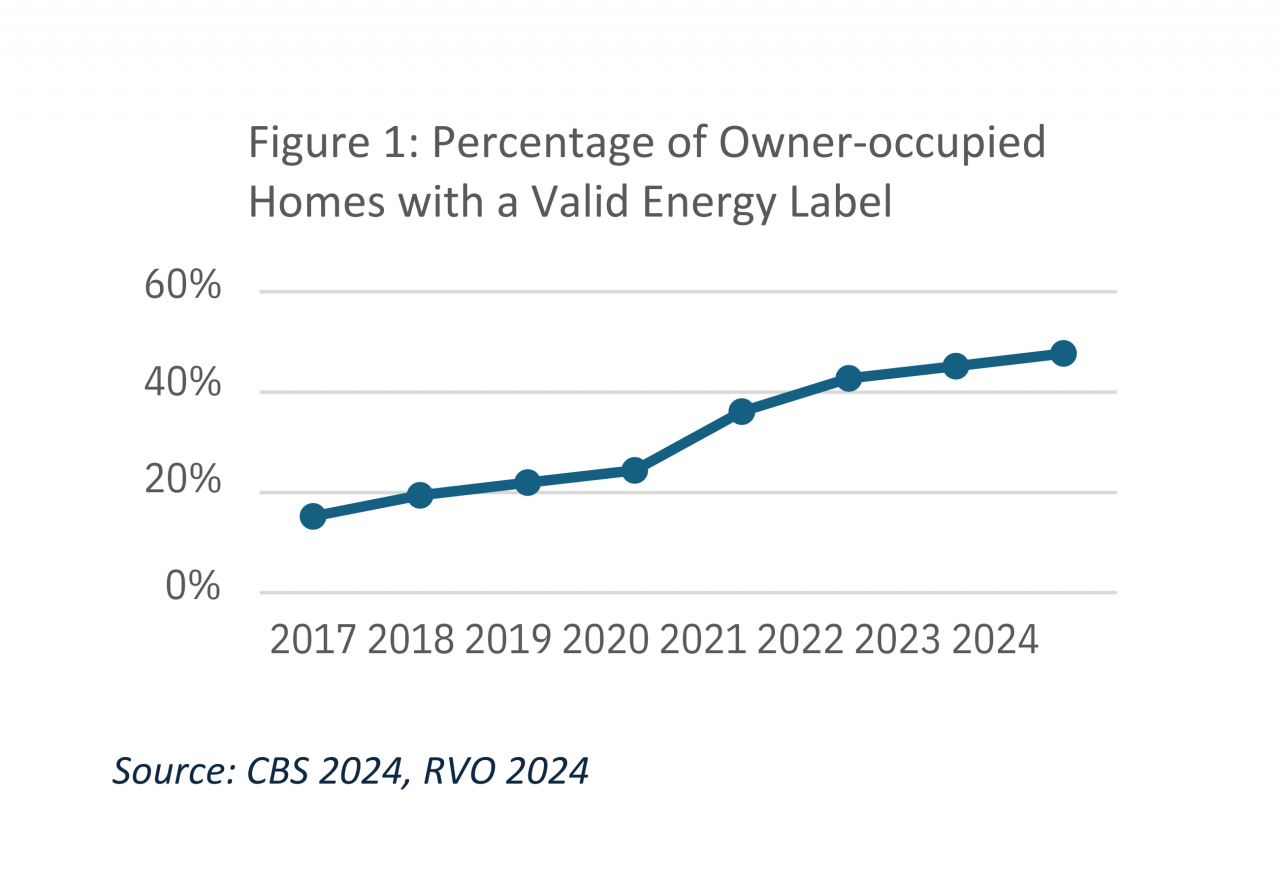Fiscalise the Costs of an Energy Label! Or remain in the dark about the progress on housing sustainability
We can no longer ignore it: sustainability is playing an increasingly important role in society, especially in the housing market. However, due to a lack of reliable and complete data, we have no idea about the progress of the sustainability transition..


Door Walter van Maurik
Portfolio Manager
- Due to unreliable and incomplete data, there is insufficient visibility on the current energy labels of the housing stock.
- According to the Climate Agreement, around 1.5 million owner-occupied homes must have at least energy label D by 2030, thus the government has an interest in monitoring the sustainability of the housing stock.
- Because homeowners have no interest in obtaining a (new) energy label, we believe it is necessary to fiscalise the costs of an energy label.
- With this proposal, the current state of the sustainability transition in the housing market becomes clear and the information is kept up-to-date.
Lack of Data
This lack of data has two causes:
- Until 2020, homes were inspected remotely, resulting in an unreliable energy label.
- Many homes have not received a (new) label after sustainability improvements, making the improvements invisible in the figures. This is because the owner has no interest in applying for a (new) label as long as they are not selling their home.
In line with the Climate Agreement[1], the first 1.5 million homes must be upgraded to at least energy label D by 2030. Furthermore, this agreement dictates that by 2050, a total of 7 million homes and 1 million buildings must be off natural gas. Due to the lack of data, we currently have insufficient knowledge of how far we have come with the sustainability of the housing stock and what still needs to be done. It is therefore crucial that the housing stock is provided with a new energy label. Since homeowners have no interest in this, we are trying to urge politicians to lend a helping hand.
DMPM’s Solution
How can this be achieved? We believe that making the costs of the energy label tax-deductible would be a good solution. And it is not illogical, given that the costs of buying a house are already tax-deductible. Below, we explain the proposed solution in more detail, provide background information, and make our case to policymakers.
Development of Energy Label Application Over Time
The energy label as we know it today has evolved over the years. Since 2008, homeowners have been required to provide an energy performance certificate when selling their home. This certificate, which later became known as the energy label, was based on an inspection of the home. Until 2020, there was the Simplified Energy Label (Vereenvoudigd Energielabel, VEL), where homeowners could provide the main characteristics of their home themselves, supplemented with the necessary documentation. The application was then reviewed remotely by a certified expert, who issued an energy label based on this information. This method cost consumers between €7.50 and €15 at the time.
On January 1, 2021, there was a significant change in the methodology for determining the energy label. The label is now based on the NTA[2] 8800 standard, which calculates the primary fossil energy use per square meter. Additionally, the A-label has been expanded with extra efficient classes (A+++ and A++++). The label is valid for 10 years from the date of receipt. The government expected the new energy label to cost an average of €100 for an apartment and €190 for a single-family home. The price development of the energy label has been monitored by the government since 2021, and possibilities for reducing the price are being explored. However, according to the Dutch Consumers' Association, the average price is higher, averaging €300[3] for all types of homes.
The Current Database is Unreliable and Incomplete
The RVO (Dutch Enterprise Agency) maintains a database with all valid energy labels of the housing stock in the Netherlands. The total housing stock in the Netherlands currently amounts to over 8.1 million homes, of which more than 4.6 million are owner-occupied. As of January 1, 2024, only 48% of the total number of owner-occupied homes in the Netherlands have a registered energy label. Therefore, the current database is unreliable and, above all, incomplete. As the energy label is valid for 10 years, the database contains many energy labels that were requested before 2021, using the Simplified Energy Label (VEL). Because the requirements for this energy label were less strict than the current ones, many of the labels issued at that time will not provide a representative view of the home.
In 2020, there was a significant increase of 50% in the number of valid energy labels for owner-occupied homes. This increase can be attributed to the fact that the application for the energy label became stricter and more expensive as of January 1, 2021. Many homeowners were quick to register for an energy label before the stricter rules and higher costs took effect.
Another aspect that is barely measured, is the improvement of the energy label per home. Currently, an energy label is only mandatory when the home is sold. This is a snapshot in time; often, homeowners start making their new home more sustainable after they have bought it. Therefore, it is difficult to report on energy label improvements per home based on the current data.

Requesting an Energy Label is a Barrier for Homeowners
Currently, homeowners mainly request an energy label when they intend to sell their property. This is because an energy label is mandatory at that point. If the cost threshold for requesting an energy label for the home is lowered or removed, homeowners will be more likely to request an updated energy label after making sustainability improvements. This will make the available data more u-to-date and complete, providing a reliable picture of the sustainability progress of the entire Dutch housing stock. As a result, changes in energy labels can be tracked better.
Importance of the Investor in an Energy Label
More and more 'green mortgages' are being offered, with a limited interest rate reduction on the part of the mortgage used for sustainability improvements. The mortgage provider would prefer the energy label to be issued both before and after the sustainability improvements, so it becomes clear what effect the mortgage is having on the energy consumption of the home. In return, investors are more willing to offer (larger) discounts. However, due to the high cost of obtaining an energy label, the homeowner gains little from an interest rate reduction. For example, if a green partial loan of €25,000 is taken out with a discount of 30 basis points, it yields €75 gross per year. Applying for an energy label costs an average of €300, which means that the cost of the energy label is only recouped after 4 years. In practice, it will take even longer because the net amount is lower due to the mortgage interest deduction.
Fiscalise the Costs of Energy Labels
One way to lower the threshold for homeowners is to make the application for an energy label fiscally attractive. Currently, the costs of an energy label are one of the few housing related expenses that are not tax deductible in Box 1. Mortgage advice, valuation reports, notary fees, brokerage fees, NHG costs, and penalty interest are all deductible. Therefore, it does not seem illogical to allow a much lower cost item such as the energy label costs to be deductible.
Based on the total housing stock and the average costs for an energy label application, we can estimate the maximum costs for the government. Currently, there are over 4.6 million owner-occupied homes, of which 48% have a valid energy label[4]. The current database largely contains of Simplified Energy Labels (VEL). To improve the reliability of the database, a large portion of owner-occupied homes with a valid energy label will need to be provided with a new energy label. From 2031 onwards, there will be no more owner-occupied homes with a Simplified Energy Label (VEL) in the database. Spreading the cost of the energy label over 6.5 years gives the following cost picture:
Currently, there are about 4.6 million owner-occupied homes. The average cost of applying for an energy label is €300. With 4.6 million owner-occupied homes, the annual costs for the government to provide each owner-occupied home with a new energy label would be approximately €215[5] million. The actual costs will be lower because some of these costs are recouped through lower mortgage interest, resulting in a lower mortgage deduction. Although €215 million may seem like a considerable amount, it is relatively modest compared to the available subsidies for homeowners who want to make their homes more sustainable.
Lowering Requirements for Active Energy Labels
Another proposal that the government could consider is to lower the requirements for updating an existing energy label, specifically for labels issued after 2021. The core idea is to introduce a streamlined update procedure that is less burdensome. Instead of having to request a completely new energy label report, it should suffice to only update the home characteristics based on the recently implemented sustainability measures. This approach would allow for the establishment of a new energy label without going through the entire process again. An important aspect of this proposal is that the original validity period of the energy label remains unchanged. Only the label itself will be updated to reflect the improved energy performance of the home. By simplifying this process, the costs for updating an energy label can be significantly reduced, which could encourage homeowners to register their sustainability measures. This approach aligns well with the practice of many homeowners improving the sustainability of their homes in multiple steps. By making energy label updates more accessible and affordable, it becomes more attractive to update the energy label after each sustainability step.
To realise this plan, a standardised method for updating home characteristics will need to be developed. Additionally, clear guidelines are needed for establishing a new energy label based on the updated data. Through this innovative approach, updating energy labels becomes not only more cost-efficient but also more accessible. This could ultimately contribute to accelerating the energy transition in the housing sector, encouraging homeowners to continue their sustainability efforts and have them recorded in an up-to-date energy label.
[1] For further background information, we refer you to: https://www.klimaatakkoord.nl/gebouwde-omgeving
[2] NTA 8800: "provides terms, definitions, and the method for determining the numerical value of the energy performance and derived indicators of a building or part of a building." For more information: www.nen.nl
[3] This amount is based on an average reported by the Consumers' Association. See: consumentenbond.nl
[4] This calculation was done by dividing the total number of valid energy labels for owner-occupied homes (RVO) by the total owner-occupied housing stock (CBS).
[5] Calculation of €215 million: 4.6 million owner-occupied homes (CBS, 2024) * €300 average price of energy label (Consumentenbond, 2024) / 6.5 years (2031-2024)